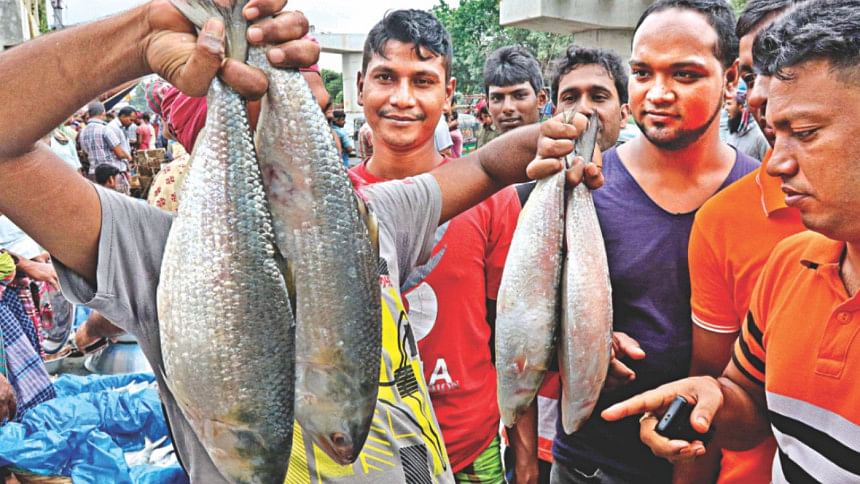22-day hilsa ban begins

A 22-day ban on catching, selling, hoarding and transporting of hilsa begins today to protect safe spawning of the popular fish during the peak breeding period.
Around 7,000 square kilometre area of rivers in 27 districts have been earmarked as the breeding ground of the hilsa, according to the fisheries and livestock ministry.
The restriction will remain effective until November 2. Shoals of mother hilsa start swimming upstream from the sea towards the rivers weeks before the full moon in October (Ashwin in Bengali calendar) and they return to the sea after spawning.
Apart from rivers of those districts, all the coastal areas and estuaries will be under the purview of the ban. Drives would be conducted to tackle catching, selling, hoarding and transporting of hilsa.
The department of fisheries took various initiatives in the districts to raise awareness among the fishermen, traders and locals about protecting mother hilsa, according to reports of our district correspondents.

The catch of hilsa has risen significantly this year thanks to better management during the fish spawning season, enhanced vigilance against hilsa catching, marketing and trading during the ban period and increased frequency of drives against offenders.
The government has been providing rice package to the fishermen, whose livelihoods, otherwise, largely depend on hilsa catching.
In Barisal, officials of the department of fisheries hung posters and banners, saying not to catch hilsa during the ban period, at different places and held views-exchange meetings with fishermen about the importance of the ban, reports our correspondent there.
Bazlur Rashid, deputy director of the department, said around 2.5 crore hilsas would be saved from catching during the 22-day ban period.
"We have allocated 20kg of rice to each of 2,37,943 fishermen families in Barisal division for the ban period," he added.
In Chandpur, the district administration allocated 731 tonnes of rice to 41,042 fishermen there, said Abdus Sabur Mandol, deputy commissioner of the district.
He said they decided to close the cold storages in the district for the next 22 days to stop hoarding of hilsa.
Shafiqur Rahman, district fisheries officer, said they held campaigns with the fishermen and locals of 20 unions in Chandpur Sadar, Hymchor, Matlab Uttar and Dakkshin upazilas to create awareness about protecting mother hilsa.
The government has been imposing fishing bans since 2003-04 to protect hilsa spawning.
But the annual ban, usually 15 days long, was extended this year as the researchers found that spawning hilsas were caught before and after the 15-day ban in the last few years.
The 27 districts where the ban would be in place are: Chandpur, Laxmipur, Noakhali, Feni, Chittagong, Cox's Bazar, Barisal, Bhola, Patuakhali, Barguna, Pirojpur, Jhalakathi, Bagerhat, Shariatpur, Brahmanbaria, Dhaka, Madaripur, Faridpur, Rajbari, Jamalpur, Narayanganj, Narsingdi, Manikganj, Munshiganj, Khulna, Kushtia and Rajshahi.

 For all latest news, follow The Daily Star's Google News channel.
For all latest news, follow The Daily Star's Google News channel. 



Comments